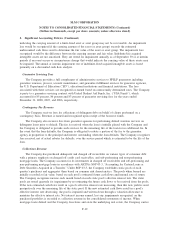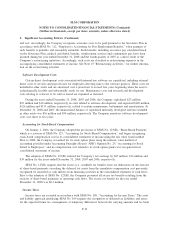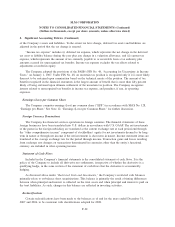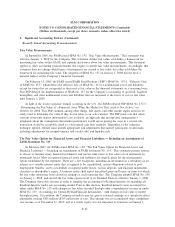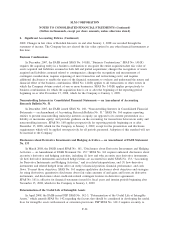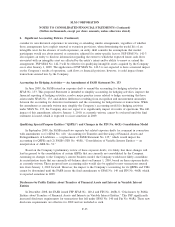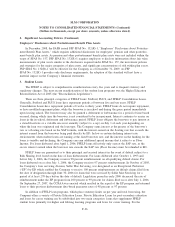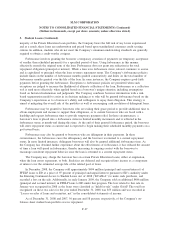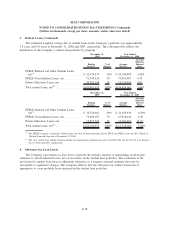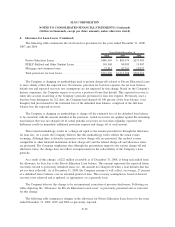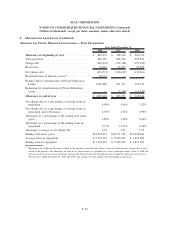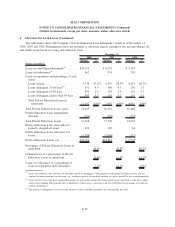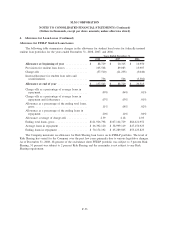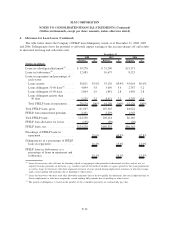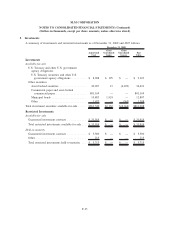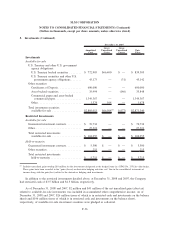Sallie Mae 2008 Annual Report Download - page 146
Download and view the complete annual report
Please find page 146 of the 2008 Sallie Mae annual report below. You can navigate through the pages in the report by either clicking on the pages listed below, or by using the keyword search tool below to find specific information within the annual report.2. Significant Accounting Policies (Continued)
Employers’ Disclosures about Postretirement Benefit Plan Assets
In December 2008, the FASB issued FSP SFAS No. 132(R)-1, “Employers’ Disclosures about Postretire-
ment Benefit Plan Assets,” which requires additional disclosures for employers’ pension and other postretire-
ment benefit plan assets. As pension and other postretirement benefit plan assets were not included within the
scope of SFAS No. 157, FSP SFAS No. 132(R)-1 requires employers to disclose information about fair value
measurements of plan assets similar to the disclosures required under SFAS No. 157, the investment policies
and strategies for the major categories of plan assets, and significant concentrations of risk within plan assets.
FSP SFAS No. 132(R)-1 will be effective for the Company as of December 31, 2009. As FSP
SFAS No. 132(R)-1 provides only disclosure requirements, the adoption of this standard will not have a
material impact on the Company’s financial statements.
3. Student Loans
The FFELP is subject to comprehensive reauthorization every five years and to frequent statutory and
regulatory changes. The most recent reauthorization of the student loan programs was the Higher Education
Reconciliation Act of 2005 (the “Reconciliation Legislation”).
There are three principal categories of FFELP loans: Stafford, PLUS, and FFELP Consolidation Loans.
Generally, Stafford and PLUS loans have repayment periods of between five and ten years. FFELP
Consolidation Loans have repayment periods of twelve to thirty years. FFELP loans do not require repayment,
or have modified repayment plans, while the borrower is in-school and during the grace period immediately
upon leaving school. The borrower may also be granted a deferment or forbearance for a period of time based
on need, during which time the borrower is not considered to be in repayment. Interest continues to accrue on
loans in the in-school, deferment and forbearance period. FFELP loans obligate the borrower to pay interest at
a stated fixed rate or a variable rate reset annually (subject to a cap) on July 1 of each year depending on
when the loan was originated and the loan type. The Company earns interest at the greater of the borrower’s
rate or a floating rate based on the SAP formula, with the interest earned on the floating rate that exceeds the
interest earned from the borrower being paid directly by ED. In low or certain declining interest rate
environments when student loans are earning at the fixed borrower rate, and the interest on the funding for the
loans is variable and declining, the Company can earn additional spread income that it refers to as Floor
Income. For loans disbursed after April 1, 2006, FFELP loans effectively only earn at the SAP rate, as the
excess interest earned when the borrower rate exceeds the SAP rate (Floor Income) must be refunded to ED.
FFELP loans are guaranteed as to their principal and accrued interest in the event of default subject to a
Risk Sharing level based on the date of loan disbursement. For loans disbursed after October 1, 1993 and
before July 1, 2006, the Company receives 98 percent reimbursement on all qualifying default claims. For
loans disbursed on or after July 1, 2006, the Company receives 97 percent reimbursement. In October of 2005,
the Company’s loan servicing division, Sallie Mae Servicing, was designated as an Exceptional Performer
(“EP”) by ED which enabled the Company to receive 100 percent reimbursement on default claims filed from
the date of designation through June 30, 2006 for loans that were serviced by Sallie Mae Servicing for a
period of at least 270 days before the date of default. Legislation passed in early 2006 decreased the rate of
reimbursement under the EP program from 100 percent to 99 percent for claims filed on or after July 1, 2006.
On September 27, 2007, the CCRAA was enacted which resulted in the repeal of the EP program and returned
loans to their previous disbursement date-based guarantee rates of 98 percent or 97 percent.
In addition to FFELP loan programs, which place statutory limits on per year and total borrowing, the
Company offers a variety of Private Education Loans. Private Education Loans for post-secondary education
and loans for career training can be subdivided into two main categories: loans that supplement FFELP
student loans primarily for higher and lifelong learning programs and loans for career training. For the
F-26
SLM CORPORATION
NOTES TO CONSOLIDATED FINANCIAL STATEMENTS (Continued)
(Dollars in thousands, except per share amounts, unless otherwise stated)





